Antivirals are agents used to treat the diseases caused by viruses such as warts and common colds.
Table of Contents
- Antiviral Drugs: Generic and Brand Names
- Disease Spotlight: Viral Diseases
- Agents for Influenza A and Respiratory Viruses
- Agents for Herpes and Cytomegaloviruses
- Agents for HIV and AIDS (Antiretroviral Drugs)
- Anti-Hepatitis B and C Agents
- Practice Quiz: Antiviral Drugs
- Recommended Resources
- See Also
- References and Sources
Antiviral Drugs: Generic and Brand Names
Here is a table of commonly encountered antivirals, their generic names, and brand names:
- Influenza A and Respiratory Viruses Drugs
- amantadine (Symmetrel)
- oseltamivir (Tamiflu)
- ribavirin (Rebetron, Virazole)
- rimantadine (Flumadine)
- zanamivir (Relenza)
- Herpes and Cytomegaloviruses (CMV) Drugs
- acyclovir (Zovirax)
- cidofovir (Vistide)
- famciclovir (Famvir)
- foscarnet (Foscavir)
- ganciclovir (Cytovene)
- valacyclovir (Valtrex)
- valganciclovir (Valcyte)
- Agents for HIV and AIDS
- Non-nucleoside Reverse Transcriptase Inhibitors
- delavirdine (Rescriptor)
- efavirenz (Sustiva)
- etravirine (Intelence)
- nevirapine (Viramune)
- rilpivirine (Edurant)
- Nucleoside Reverse Transcriptase Inhibitors (NRTI)
- abacavir (Ziagen)
- didanosine (Videx)
- emtricitabine (Emtriva)
- lamivudine (Epivir)
- stavudine (Zerit XR)
- tenofovir (Viread)
- zidovudine (AZT) (Retrovir, Aztec)
- Protease Inhibitors
- atazanavir (Reyataz)
- darunavir (Prezista)
- fosamprenavir (Lexiva)
- indinavir (Crixivan)
- lopinavir (Kaletra)
- nelfinavir (Viracept)
- ritonavir (Norvir)
- saquinavir (Fortovase)
- tipranavir (Aptivus)
- Fusion Inhibitors
- enfurvirtide (Fuzeon)
- CCR5 Coreceptor Antagonists
- maraviroc (Selzentry)
- Integrase Inhibitors
- raltegravir (Isentress)
- Non-nucleoside Reverse Transcriptase Inhibitors
- Anti Hepatitis B Agents
- adefovir (Hepsera)
- entecavir (Baraclude)
- telbivudine (Tyzeka)
- Anti Hepatitis C Agents
- boceprevir (Victrelis)
- telaprevir (Incivek)
- Locally Active Antiviral Agents
- docosanol (Abreva)
- ganciclovir (Vitrasert)
- imiquimod (Aldara)
- penciclovir (Denavir)
- trifluridine (Viroptic)
Disease Spotlight: Viral Diseases
- Viruses are composed of a single DNA or RNA inside a protein coat. Viruses must enter a cell in order for them to carry on with their metabolic processes.
- Upon successful entry, viruses inject their DNA or RNA to the cell and the cell is altered in such a manner that it is now “programmed” to control the metabolic processes that the virus needs to survive.
- Because viruses are contained in the cells, researchers find it difficult to develop vaccines. However, viruses respond to some antiviral therapy including influenza A viruses, herpes viruses, CMV, HIV, hepatitis B and C viruses, and some viruses that cause warts and eye infections.
Agents for Influenza A and Respiratory Viruses
- These agents are used to treat the signs and symptoms of respiratory flu caused by influenza A and B viruses as well as respiratory syncytial viruses (RSV). While vaccines are available, drug therapy would be the best option if patients manifest the viral infection and spontaneous resolution does not occur.
Therapeutic Action
The desired and beneficial action of agents for respiratory viruses is:
- Unknown. However, the belief is that these agents prevent shedding of the viral protein coat and entry of the virus into the cell. This prevents replication and therefore causes viral death.
Indications
Agents for respiratory viruses are indicated for the following medical conditions:
- Respiratory flu, especially in health care workers and high-risk individuals
- Oseltamivir is the only antiviral agent that has been shown to be effective in treating H1N1 and avian flu.
- Zidovudine has been safely used in pregnant women.
Here are some important aspects to remember for indication of agents for respiratory viruses in different age groups:
Children
- This age group is very sensitive to the effects of most antivirals and therefore more severe reactions can be expected.
- In addition, many antivirals do not have proven safety and efficacy in children.
- Caution must be applied and smaller doses are given for children.
Adults
- This age group should be educated about the dangers of using antibiotics for viral diseases.
- Emphasis is given on patients with HIV about the limitations of antiviral drugs with regards to the curative aspect of the disease.
Pregnant women
- Generally, pregnant women are not given antivirals unless the benefits clearly outweigh the risks to the fetus or neonate.
- Women of childbearing age should be advised to use barrier contraceptives if they take any of these drugs.
- The Centers for Disease Control and Prevention (CDC) advises that women with HIV infection should not breast-feed to protect the neonate from the viruses.
Older adults
- Older patients are more susceptible to adverse effects of antiviral therapy, particularly those with hepatic and renal dysfunctions.
Pharmacokinetics
Here are the characteristic interactions of agents for respiratory viruses and the body in terms of absorption, distribution, metabolism, and excretion:
| Route | Onset | Peak | Duration |
| Oral | Slow | 6 h | N/A |
| T1/2: 25.4 h Metabolism: none Excretion: kidney (urine); unchanged |
Contraindications and Cautions
The following are contraindications and cautions for the use of agents for respiratory viruses:
- Renal impairment. Alters metabolism and excretion of drugs, particularly amantadine, zanamivir, and oseltamivir.
- Pregnancy and lactation. Amantadine, rimantadine, and oseltamivir should only be used for treatment if benefits outweigh the risks.
Adverse Effects
Use of agents for respiratory viruses may result to these adverse effects:
- CNS: adverse effects that may be related to possible effects of dopamine levels in the brain, like light-headedness, dizziness, insomnia
- CV: orthostatic hypotension
- GU: urinary retention
Interactions
The following are drug-drug interactions involved in the use of agents for respiratory viruses:
- Anticholinergics: increased atropine-like effects with amantadine or rimantadine
- Acetaminophen and aspirin: loss of these drugs’ effectiveness with rimantadine
- Antacids: reduced effectiveness of ribavirin
- NRTIs: reduced effectiveness of ribavirin
- Isoniazid: increased incidence of rifampin-related hepatitis
- Antiarrhythmics, hormonal contraceptives, corticosteroids, antifungals, CNS depressants: decreased effectiveness of these drugs if combined with rifampin
- St. John’s wort: decreased serum levels of protease inhibitors; increased metabolism of antivirals metabolized through cytochrome P450 system
Nursing Considerations
Here are important nursing considerations when administering antiviral agents for influenza A and other respiratory viruses:
Nursing Assessment
These are the important things the nurse should include in conducting assessment, history taking, and examination:
- Assess for the mentioned cautions and contraindications (e.g. drug allergies, hepatorenal impairment, pregnancy and lactation, etc.) to prevent any untoward complications.
- Perform a thorough physical assessment (other medications taken, orientation and reflexes, vital signs, etc.) to establish baseline data before drug therapy begins, to determine effectiveness of therapy, and to evaluate for occurrence of any adverse effects associated with drug therapy.
Nursing Diagnoses
Here are some of the nursing diagnoses that can be formulated in the use of these drugs for therapy:
- Acute pain related to GI, CNS, or GU effects of the drug
- Disturbed sensory perception (kinesthetics) related to CNS effects of the drug
Implementation with Rationale
These are vital nursing interventions done in patients who are taking antiviral agents for respiratory viruses:
- Administer drug as prescribed as soon after exposure to the virus is possible to enhance effectiveness and decrease the risk of complications due to viral infection.
- Administer influenza A vaccine before the flu season begins, if at all possible, to decrease the risk of contracting the flu and decrease the risk of complications.
- Instruct the patient about the appropriate dosage scheduling regimen; safety precautions, including changing position slowly and avoiding driving and hazardous tasks that should be taken if CNS effects occur; the need to report any adverse effects such as difficulty walking or talking to enhance the patient knowledge about drug therapy and to promote compliance.
- Educate client on drug therapy to promote understanding and compliance.
Evaluation
Here are aspects of care that should be evaluated to determine effectiveness of drug therapy:
- Monitor patient response to therapy (prevention of respiratory flu-like symptoms and alleviation of flu-like symptoms).
- Monitor for adverse effects (e.g. changes in orientation and affect, blood pressure, urinary output, liver or renal function test changes, etc).
- Evaluate patient understanding on drug therapy by asking patient to name the drug, its indication, and adverse effects to watch for.
- Monitor patient compliance to drug therapy.
Agents for Herpes and Cytomegaloviruses
- These agents are used to the infections caused by herpes (e.g. cold sores, encephalitis, shingles, and genital infections) and CMV (e.g. infections affecting the eyes, respiratory tract, and liver).
Therapeutic Action
The desired and beneficial action of agents for herpes virus and CMV is:
- Inhibiting viral DNA replication by competing with viral substrates to form shorter, noneffective DNA chains.
Indications
Agents for herpes virus and CMV are indicated for the following medical conditions:
- Infections caused by DNA viruses herpes simplex, herpes zoster, and CMV
- Effective in immunocompromised individuals (e.g. patients with AIDS and multiple infections)
- Acyclovir is the drug of choice for children with herpes virus or CMV infections.
Pharmacokinetics
Here are the characteristic interactions of agents for herpes virus and CMV and the body in terms of absorption, distribution, metabolism, and excretion:
| Route | Onset | Peak | Duration |
| Oral | Varies | 1.5-2 h | Not known |
| IV | Immediate | 1 h | 8 h |
| Topical | Not generally absorbed systematically | ||
| T1/2: 2.5-5 h Metabolism: none Excretion: kidney (urine); unchanged |
Contraindications and Cautions
The following are contraindications and cautions for the use of agents for herpes virus and CMV:
- Known allergy to drug. Prevent hypersensitivity reactions
- Renal impairment. Alter drug excretion
- Pregnancy and lactation. Prevent adverse effects to fetus or neonate
- Severe CNS disorders. Drugs can cause headache, neuropathy, paresthesias, confusion, and hallucinations
- Children with AIDS. Cidofovir has potential carcinogenic effects and effects on fertility. Caution must be applied.
- Children. Foscarnet, ganciclovir, and valganciclovir can affect bone development and growth. Also, safety of use in children younger than 18 years has not been established for famciclovir.
Adverse Effects
Use of agents for herpes virus and CMV may result to these adverse effects:
- CNS: headache, depression, paresthesias, neuropathy
- GI: nausea, vomiting
- GU: renal dysfunction and failure
- IV and topical site: rash, inflammation, burning sensation
- Cidofovir is associated with severe renal toxicity and granulocytopenia.
- Ganciclovir and valganciclovir are associated with bone marrow suppression.
- Foscarnet has been associated with seizures, especially in patients with electrolyte imbalance.
Interactions
The following are drug-drug interactions involved in the use of agents for herpesvirus and CMV:
- Aminoglycosides: increased renal toxicity
- Zidovudine: increased risk of drowsiness
Nursing Considerations
Here are important nursing considerations when administering antiviral agents for herpesvirus and CMV:
Nursing Assessment
These are the important things the nurse should include in conducting assessment, history taking, and examination:
- Assess for the mentioned cautions and contraindications (e.g. drug allergies, hepatorenal impairment, pregnancy and lactation, severe CNS disorders, etc.) to prevent any untoward complications.
- Perform a thorough physical assessment (other medications taken, orientation and reflexes, skin color, temperature, and lesions, etc.) to establish baseline data before drug therapy begins, to determine effectiveness of therapy, and to evaluate for occurrence of any adverse effects associated with drug therapy.
- Evaluate renal function tests to determine baseline function of the kidneys and to assess adverse effects on the kidney and need to adjust the dose of the drug.
Nursing Diagnoses
Here are some of the nursing diagnoses that can be formulated in the use of these drugs for therapy:
- Acute pain related to GI, CNS, or local effects of the drug
- Disturbed sensory perception (kinesthetics) related to CNS effects of the drug
Implementation with Rationale
These are vital nursing interventions done in patients who are taking antiviral agents for respiratory viruses:
- Administer drug as prescribed as soon after exposure to the virus is possible to enhance effectiveness and decrease the risk of complications due to viral infection.
- Ensure good hydration to decrease the toxic effects on the kidneys.
- Ensure patient takes the complete course of the drug regimen to improve effectiveness and decrease the risk of emergence of resistant viruses.
- Wear protective gloves when applying the drug topically to decrease the risk of exposure to the drug and inadvertent absorption.
- Provide safety precautions (e.g. use of side rails, appropriate lighting, orientation, assistance) if CNS effects occur to protect the patient from injury.
- Monitor renal function tests periodically during treatment to ensure prompt detection and early intervention should renal toxicity develop.
- Educate client on drug therapy to promote understanding and compliance.
- Provide the following patient teaching:
- Avoid sexual intercourse if genital herpes is being treated because these drugs do not cure the disease.
- Wear protective gloves when applying topical agents.
- Avoid driving and hazardous tasks if dizziness or drowsiness occurs.
Evaluation
Here are aspects of care that should be evaluated to determine effectiveness of drug therapy:
- Monitor patient response to therapy (alleviation of signs and symptoms of herpes or CMV).
- Monitor for adverse effects (e.g. orientation and affect, GI upset and renal function).
- Evaluate patient understanding on drug therapy by asking patient to name the drug, its indication, and adverse effects to watch for.
- Monitor patient compliance to drug therapy.
Agents for HIV and AIDS (Antiretroviral Drugs)
Nonnucleoside Reverse Transcriptase Inhibitors
- This antiretroviral drug has direct effects on HIV activities within the cell.
Therapeutic Action
The desired and beneficial action of this antiretroviral drug is:
- Binding directly to HIV reverse transcriptase to block both RNA- and DNA-dependent DNA polymerase activities. They prevent the transfer of information that would allow the virus to carry on the formation of viral DNA. Consequently, replication becomes impossible.
Indications
Nonnuceloside reverse transcriptase inhibitors are indicated for the following medical conditions:
- Treatment of patients with documented AIDS or ARC who have decreased numbers of helper T cells and evidence of increased opportunistic infections in combination with other antiviral drugs.
Pharmacokinetics
Here are the characteristic interactions of nonnucleoside reverse transcriptase inhibitors and the body in terms of absorption, distribution, metabolism, and excretion:
| Route | Onset | Peak | Duration |
| Oral | Rapid | 4 h | N/A |
| T1/2: 45 h, then 25-30 h Metabolism: liver Excretion: kidney (urine) |
Contraindications and Cautions
The following are contraindications and cautions for the use of nonnucleoside reverse transcriptase inhibitors:
- Pregnancy. No adequate studies of nonnucleoside reverse transcriptase inhibitors so use should be limited only in which benefits clearly outweigh any risks.
- Children. Safety for the use of delavirdine is not established.
Adverse Effects
Use of nonnucleoside reverse transcriptase inhibitors may result to these adverse effects:
- CNS: dizziness, blurred vision, headache
- GI: dry mouth, constipation or diarrhea, nausea, abdominal pain, dyspepsia
- Flu-like syndrome may occur but this may also be because of the underlying disease.
Interactions
The following are drug-drug interactions involved in the use of nonnucleoside reverse transcriptase inhibitors:
- Delavirdine should not be combined with antiarrhythmics, clarithromycin, dapsone, antituberculosis drugs, calcium-channel blockers, warfarin, quinidine, indinavir, saquinavir, or dapsone.
- Efavirenz should not be combined with midazolam, rifabutin, triazolam, or ergot derivatives.
- Hormonal contraceptives and protease inhibitors: lack of effectiveness of nevirapine
- St. John’s wort: decreased antiviral effects
Nucleoside Reverse Transcriptase Inhibitors (NRTIs)
- This antiretroviral drug was the first class of drug developed to treat HIV infections. This competes with the naturally occurring nucleosides within a human cell that the virus would need to develop.
Therapeutic Action
The desired and beneficial action of this antiretroviral drug is:
- Competing with the naturally occurring nucleosides within the cell that the virus would use to build DNA chain. These nucleosides, however, lack a substance needed to extend the DNA chain. Consequently, chain cannot lengthen and insert itself into the host DNA.
Indications
NRTIs are indicated for the following medical conditions:
- Combination therapy for the treatment of adults and children with HIV
- Lamivudine as an oral solution can be used in treatment of chronic hepatitis B
- Zidovudine is used in prevention of maternal transmission of HIV.
Pharmacokinetics
Here are the characteristic interactions of nonnucleoside NRTIs and the body in terms of absorption, distribution, metabolism, and excretion:
| Route | Onset | Peak | Duration |
| Oral | Varies | 30-90 min | N/A |
| IV | Rapid | End of infusion | N/A |
| T1/2: 30-60 min Metabolism: liver Excretion: kidney (urine) |
Contraindications and Cautions
The following are contraindications and cautions for the use of NRTIs:
- Pregnancy. No adequate studies of NRTIs so use should be limited, except for zidovudine, which has been proven to be safe.
- Hepatic dysfunction, severe renal impairment. Caution with use of tenofovir, zidovudine, and emtricitabine.
- Bone marrow suppression. Can be aggravated by zidovudine.
Adverse Effects
Use of NRTIs may result to these adverse effects:
- Abacavir: serious-to-fatal hypersensitivity reactions (fever, chills, rash, fatigue, GI upset, flu-like symptoms) can occur and drug must be discontinued immediately and listed with the Abacavir Hypersensitivity Registry
- Didanosine: serious pancreatitis, hepatomegaly, and neurological problems
- Emtricitabine, tenofovir: severe and fatal hepatomegaly with steatosis
- Zidovudine: severe bone marrow suppression
- Tenofovir: changes in body fat distribution, with loss of fat from arms, legs, and face and deposition of fat on the trunk, neck, and face.
Interactions
The following are drug-drug interactions involved in the use of NRTIs:
- Tenofovir: increase serum level of didanosine; if in combine therapy, administer 2 hours before or 1 hour after didanosine was given
- Alcohol: severe toxicity with abacavir
- Antibiotics, antifungals: decreased effectiveness of these drugs if combined with didanosine
- Cyclosporine: severe drowsiness and lethargy if combined with zidovudine
- Lamivudine and zalcitabine inhibit the effects of each other.
Protease Inhibitors
- Protease inhibitors block protease activity within the HIV virus.
Therapeutic Action
The desired and beneficial action of this antiretroviral drug is:
- Rendering the virus immature and noninfective by blocking protease which is essential for the maturation of an infectious virus.
- As a result, the virus is unable to fuse with and inject itself into a cell.
Indications
Protease inhibitors are indicated for the following medical conditions:
- Combination therapy for the treatment of HIV infections.
Pharmacokinetics
Here are the characteristic interactions of nonnucleoside NRTIs and the body in terms of absorption, distribution, metabolism, and excretion:
| Route | Onset | Peak | Duration |
| Oral | Varies | 1.5-4 min | N/A |
| T1/2: 7.7 h Metabolism: liver Excretion: kidney (urine) |
Contraindications and Cautions
The following are contraindications and cautions for the use of protease inhibitors:
- Pregnancy, lactation. Only saquinavir is not teratogenic. However, it can cross into breast milk.
- Hepatic dysfunction. Increased toxicity especially with fosamprenavir and darunavir
- Patients taking antidiabetic drugs. Darunavir can cause diabetes mellitus and/or hyperglycemia; dose adjustment is required.
- Darunavir is associated with mild to severe dermatologic reactions including Steven Johnson syndrome.
- Safety of indinavir for use in children younger than 12 years has not been established.
- Darunavir should not be used in children younger than 3 years of age because of the potential for toxic effects.
Adverse Effects
Use of protease inhibitors may result to these adverse effects:
- GI: nausea, vomiting, diarrhea, anorexia, changes in liver function (elevated cholesterol and triglyceride)
- Skin: rashes, pruritus, Steven Johnson syndrome
Interactions
The following are drug-drug interactions involved in the use of protease inhibitors:
- Pimozide, rifampin, triazolam, midazolam: severe toxic effects with nelfinavir
- Nonsedating antihistamines, sedatives/hypnotics, antiarrhythmics: many potentially serious toxic effects with ritonavir
Fusion Inhibitor
- This antiretroviral drug was introduced in 2003.
- Acts on different site than do other HIV antivirals.
Therapeutic Action
The desired and beneficial action of this antiretroviral drug is:
- Preventing the fusion of the virus with the human cellular membrane, thereby preventing entry of HIV-1 virus into the cell.
Indications
Fusion inhibitors are indicated for the following medical conditions:
- Combination therapy for the treatment of adults and children older than 6 years who have evidence of HIV-1 replication despite ongoing antiretroviral therapy.
Pharmacokinetics
Here are the characteristic interactions of fusion inhibitors and the body in terms of absorption, distribution, metabolism, and excretion:
| Route | Onset | Peak | Duration |
| Subcutaneous | Slow | 4-8 h | N/A |
| T1/2: 3.2-4.4 h Metabolism: liver; tissues recycle the amino acids Excretion: N/A |
Contraindications and Cautions
The following are contraindications and cautions for the use of fusion inhibitors:
- Pregnancy and lactation. Potential adverse effects to the fetus and neonate.
- Known hypersensitivity to the drug.
Adverse Effects
Use of fusion inhibitors may result to these adverse effects:
- CNS: insomnia, depression, peripheral neuropathy
- GI: nausea, diarrhea
- Respiratory: pneumonia
- Local: injection-site reactions
Interactions
- No reported drug interactions, but caution should be used when it is combined with any drug.
CCR5 Coreceptor Antagonist
- This antiretroviral drug was introduced in 2007.
Therapeutic Action
The desired and beneficial action of this antiretroviral drug is:
- Blocking the receptor site on the cell membrane to which the HIV virus needs to interact to enter the cell.
Indications
CCR5 coreceptor antagonists are indicated for:
- Combination therapy with other antivirals.
Pharmacokinetics
Here are the characteristic interactions of CCR5 coreceptor antagonists and the body in terms of absorption, distribution, metabolism, and excretion:
| Route | Onset | Peak | Duration |
| Oral | Slow | 0.5-4 h | N/A |
| T1/2: 14-28 h Metabolism: liver Excretion: kidney (urine), colon (feces) |
Contraindications and Cautions
The following are contraindications and cautions for the use of CCR5 coreceptor antagonists:
- Pregnancy, lactation, known hypersensitivity to drugs.
- Renal impairment. Increased risk of toxicity.
- Safety of use for children not established.
Adverse Effects
Use of CCR5 coreceptor antagonists may result to these adverse effects:
- CNS: dizziness, changes in consciousness
- Severe hepatotoxicity has been reported with maraviroc, often preceded with systemic allergic reaction with eosinophilia and rash.
Interactions
The following are drug-drug interactions involved in the use of CCR5 coreceptor antagonists:
- Cyctochrome P450 CYP3A inhibitors (ketoconazole, lopinavir/ritonavir, saquinavir, ritonavir, atazanavir, delavirdine): risk of increased serum levels and toxicity of maraviroc.
- CYP3A inducers (nevirapine, rifampin, efavirenz: decreased serum levels and loss of effectiveness of maraviroc
- St. John’s wort: loss of antiviral effect of maraviroc
Integrase Inhibitors
- This antiretroviral drug was released in late 2007.
Therapeutic Action
The desired and beneficial action of this antiretroviral drug is:
- Inhibiting the activity of the virus-specific enzyme integrase, an encoded enzyme needed for replication. Blocking integrase prevents the formation of HIV-1 provirus leading to decreased viral load and increased active CD4 cells.
Indications
Integrase inhibitors are indicated for:
- Reserved for use in patients who have been treated with other antivirals and have evidence of a return to viral replication.
Pharmacokinetics
Here are the characteristic interactions of integrase inhibitors and the body in terms of absorption, distribution, metabolism, and excretion:
| Route | Onset | Peak | Duration |
| Oral | Rapid | 3 h | N/A |
| T1/2: 9 h Metabolism: liver Excretion: kidney (urine), colon (feces) |
Contraindications and Cautions
The following are contraindications and cautions for the use of integrase inhibitors:
- It is contraindicated with known hypersensitivity to any component of the drug, as initial treatment for adults, for use in children, and for nursing mothers.
- Caution should be used if the patient is at risk for rhabdomyolysis or myopathy and during pregnancy.
Adverse Effects
Use of integrase inhibitors may result to these adverse effects:
- CNS: headache, dizziness
- Musculoskeletal: rhabdomyolysis, myopathy
Interactions
The following are drug-drug interactions involved in the use of integrase inhibitors:
- Rifampin: decreased serum levels of raltegravir
- St. John’s wort: reduced effectiveness of antiviral
Nursing Considerations for Antiretroviral Drugs
Here are important nursing considerations when administering antiretroviral drugs:
Nursing Assessment
These are the important things the nurse should include in conducting assessment, history taking, and examination:
- Assess for the mentioned cautions and contraindications (e.g. drug allergies, hepatorenal impairment, pregnancy and lactation, etc.) to prevent any untoward complications.
- Perform a thorough physical assessment (other medications taken, orientation and reflexes, vital signs, skin color, temperature, and lesions, etc.) to establish baseline data before drug therapy begins, to determine effectiveness of therapy, and to evaluate for occurrence of any adverse effects associated with drug therapy.
- Evaluate hepatic and renal function tests to determine baseline function of the kidneys and liver.
- Check results of CBC with differential to monitor bone marrow activity and helper T cell number to determine the severity of the disease and indicate the effectiveness of the drugs.
Nursing Diagnoses
Here are some of the nursing diagnoses that can be formulated in the use of these drugs for therapy:
- Acute pain related to GI, CNS, or dermatological effects of the drug
- Disturbed sensory perception (kinesthetics) related to CNS effects of the drug
- Imbalanced nutrition: less than body requirements related to GI effects of the drug
Implementation with Rationale
These are vital nursing interventions done in patients who are taking antiretroviral drugs:
- Monitor renal and hepatic function before and during therapy to detect changes requiring dose adjustments or additional treatment as needed.
- Ensure patient takes the complete course of the drug regimen and takes all drugs included in a particular combination to improve the effectiveness of the drug and decrease the risk of emergency of resistant viral strains.
- Administer the drug round the clock, if indicated, to provide the critical concentration needed for the drug to be effective.
- Stop drug if sever rash occurs, especially if accompanied by blisters, fever, and other signs, to avert potentially serious reactions.
- Provide safety precautions (e.g. use of side rails, appropriate lighting, orientation, assistance) If CNS effects occur, to protect patient from injury.
- Educate client on drug therapy to promote understanding and compliance.
Evaluation
Here are aspects of care that should be evaluated to determine effectiveness of drug therapy:
- Monitor patient response to therapy (alleviation or reduction of signs and symptoms of AIDS or ARC and maintenance of helper T cell levels).
- Monitor for adverse effects (e.g. changes in orientation and affect, GI upset, renal and hepatic function, skin, levels of blood components, etc).
- Evaluate patient understanding on drug therapy by asking patient to name the drug, its indication, and adverse effects to watch for.
- Monitor patient compliance to drug therapy.
Anti-Hepatitis B and C Agents
- Hepatitis B is a serious-to-potentially fatal viral infection of the liver. It can be spread by blood or blood products, sexual contact, or contaminated needles or instruments. Individuals affected may develop a chronic condition or become a carrier.
- Hepatitis C is the leading cause of most liver transplants due to progressive liver disease. After initial infection with HCV, most people develop chronic hepatitis C while some will develop cirrhosis of the liver. Mode of transmission is similar with HBV.
Therapeutic Action
The desired and beneficial action of this anti-hepatitis drug is:
- Anti-hepatitis B agents inhibit reverse transcriptase in hepatitis B virus and cause DNA chain termination, leading to blocked viral replication and decreased viral load.
Indications
Anti-hepatitis agents are indicated for:
- Treatment of adults with chronic hepatitis B and C who have evidence of active viral replication and either evidence of persistent elevations in serum aminotransferase or histologically active disease.
Pharmacokinetics
Here are the characteristic interactions of anti-hepatitis agents and the body in terms of absorption, distribution, metabolism, and excretion:
| Route | Onset | Peak | Duration |
| Anti-hepatitis B: oral | Rapid | 0.6-4 h | Unknown |
| T1/2: 7.5 h Metabolism: liver Excretion: kidney (urine) |
Contraindications and Cautions
The following are contraindications and cautions for the use of anti-hepatitis agents:
- Anti-hepatitis B: known allergy to drugs, to prevent hypersensitivity reactions; lactation, to prevent potential toxicity to the infant; renal and liver impairment, because of increased risk of toxicity.
- Anti-hepatitis C: pregnancy, hepatitis B, and HIV infections, as safety is not established.
Adverse Effects
Use of anti-hepatitis agents may result to these adverse effects:
- Anti-hepatitis B: should not be stopped immediately because of potential risk of hepatitis B exacerbation
- CNS: headache, dizziness, nausea
- GI: diarrhea, elevated liver enzymes, severe hepatomegaly with steatosis
- GU: lactic acidosis and renal impairment
- Anti-hepatitis C
- CNS: headache, fatigue
- GI: nausea, diarrhea
- Immunological: bone marrow suppression, severe skin reactions
Interactions
The following are drug-drug interactions involved in the use of anti-hepatitis agents:
- Nephrotoxic drugs: increased risk of renal toxicity
Nursing Considerations
Here are important nursing considerations when administering anti-hepatitis drugs:
Nursing Assessment
These are the important things the nurse should include in conducting assessment, history taking, and examination:
- Assess for the mentioned cautions and contraindications (e.g. drug allergies, hepatorenal impairment, pregnancy and lactation, etc.) to prevent any untoward complications.
- Perform a thorough physical assessment (other medications taken, orientation and reflexes, vital signs, etc.) to establish baseline data before drug therapy begins, to determine effectiveness of therapy, and to evaluate for occurrence of any adverse effects associated with drug therapy.
- Evaluate hepatic and renal function tests to determine baseline function of the kidneys and liver.
Nursing Diagnoses
Here are some of the nursing diagnoses that can be formulated in the use of these drugs for therapy:
- Acute pain related to GI and CNS effects of the drug
- Imbalanced nutrition: less than body requirements related to GI effects of the drug
Implementation with Rationale
These are vital nursing interventions done in patients who are taking anti-hepatitis drugs:
- Monitor renal and hepatic function before and during therapy to detect changes requiring dose adjustments or additional treatment as needed.
- Withdraw the drug and monitor the patient if he or she develops signs of lactic acidosis or hepatotoxicity because these adverse effects can be life threatening.
- Caution patient to not run out of this drug but to take it continually because acute exacerbation of hepatitis B can occur when the drug is stopped.
- Advise patients that these drugs do not cure the disease and there is still a risk of transferring the disease, so the patient should continue to take appropriate steps to prevent transmission of hepatitis B.
- Provide the following patient teachings:
- Educate client on drug therapy to promote understanding and compliance.
Evaluation
Here are aspects of care that should be evaluated to determine effectiveness of drug therapy:
- Monitor patient response to therapy (decreased viral load).
- Monitor for adverse effects (e.g. liver or renal dysfunction, headache, nausea, diarrhea, etc).
- Evaluate patient understanding on drug therapy by asking patient to name the drug, its indication, and adverse effects to watch for.
- Monitor patient compliance to drug therapy.
Practice Quiz: Antiviral Drugs
Here are some practice questions for this study guide. Please visit our nursing test bank page for more NCLEX practice questions.
1. A 15 y/o patient came in for a severe case of respiratory flu and would need drug therapy. Which of the following drugs should the nurse anticipate to be prescribed?
A. acyclovir (Zovirax)
B. amantadine (Symmetrel)
C. abacavir (Ziagen)
D. ganciclovir (Cytovene)
1. Answer: B. amantadine (Symmetrel).
- It is indicated for respiratory viruses.
- Options A and D are for herpes viruses and CMV
- Option C is an NRTI and is indicated for HIV and AIDS.
2. Which of the following antiviral agents is effective as treatment for H1N1?
A. zidovudine
B. acyclovir
C. oseltamivir
D. Selzentry
2. Answer: C. oseltamivir. It is the only antiviral agent effective for H1N1 and avian flu.
- Option A is the only antiviral agent allowed for use in pregnant women.
- Option B is the drug of choice for herpes and CMV infections in children.
- Lastly, option D is a brand name of maraviroc, a CCR5 coreceptor antagonist of HIV virus.
3. A student nurse administering acyclovir was asked by the clinical instructor on how the drug works. The student nurse would be correct by stating that this drug works in which way?
A. unknown; but it is believed to be shedding the protein coat of the virus.
B. it competes with viral receptors found in the host cells
C. it takes away the necessary substances needed by viruses to form DNA chains
D. trapping the viruses and disintegrating them directly
3. Answer: C. it takes away the necessary substances needed by viruses to form DNA chains.
Agents for CMV and herpes viruses are known to compete with the substrates needed by viruses for this process leading to formation of shorter and noneffective DNA chains. Option A is the mechanism of action of agents for influenza and respiratory viruses.
4. Which of the following prescribed antiviral should the nurse question for a patient with severe hypokalemia?
A. Foscarnet
B. Cidofovir
C. Valganciclovir
D. Nevirapine
4. Answer: A. Foscarnet.
It can cause seizures in patients with electrolyte disturbances.
5. Which enzyme is essential for the maturation of infectious viruses?
A. reverse transcriptase
B. protease
C. nucleosidase
D. CCR5-ase
5. Answer: B. protease.
This is where the mechanism of action of protease inhibitors is anchored. As a result, viruses are unable to fuse and inject into a cell.
6. A senior nurse would be correct to advise her colleague to monitor which parameter in patients receiving cyclosporine and zidovudine at the same time?
A. skin lesion, temperature, and color
B. flu-like symptoms
C. level of consciousness
D. CBC with differential count
6. Answer: C. level of consciousness.
Severe drowsiness and lethargy can occur in patients taking these drugs at the same time.
7. The only protease inhibitor that is not teratogenic.
A. darunavir
B. indinavir
C. fosamprenavir
D. saquinavir
7. Answer: D. saquinavir.
However, this drug can cross into breast milk.
8. Anti-hepatitis B agent’s most severe adverse effect is ___________.
A. bone marrow suppression
B. steatosis
C. lactic acidosis
D. severe skin reactions
8. Answer: C. lactic acidosis.
This is accompanied by renal impairment. Option A and D are for anti-hepatitis C agents.
Recommended Resources
Our recommended nursing pharmacology resources and books:
Disclosure: Included below are affiliate links from Amazon at no additional cost from you. We may earn a small commission from your purchase which will help support us. Thank you! For more information, check out our privacy policy.
Pharm Phlash! Pharmacology Flash Cards #1 BEST SELLER!
Test-yourself review cards put critical clinical information for nearly 400 of the top generic medications at your fingertips. And, you can count on them for accuracy, because each card is based on content from Davis’s Drug Guide for Nurses. Increase your test scores in pharmacology class.
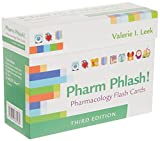
Focus on Pharmacology (8th Edition)
Focus on Nursing Pharmacology makes challenging concepts more approachable. Engaging learning features cultivate your clinical application, critical thinking and patient education capabilities. This updated 8th edition builds on your knowledge of physiology, chemistry and nursing fundamentals to help you conceptualize need-to-know information about each group of drugs.
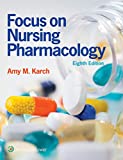
Pharmacology Made Incredibly Easy (Incredibly Easy! Series®)
Nursing pharmacology guide offers step-by-step guidance so you can grasp the fundamentals in enjoyable Incredibly Easy style. This is the perfect supplement to class materials, offering solid preparation for NCLEX® as well as a handy refresher for experienced nurses. Colorfully illustrated chapters offer clear, concise descriptions of crucial nursing pharmacology concepts and procedures.

Lehne’s Pharmacology for Nursing Care (11th Edition)
The Eleventh Edition of Lehne’s Pharmacology for Nursing Care provides a thorough understanding of key drugs and their implications for nursing care. This text, written by renowned nursing educators, helps you comprehend and apply pharmacology principles. A clear and engaging writing style simplifies complex concepts, making even the most challenging pharmacology content enjoyable. We recommend this book if you want a comprehensive nursing pharmacology guide.
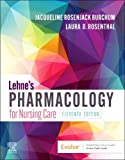
Nursing Drug Handbook
Nursing2023 Drug Handbook delivers evidence-based, nursing-focused drug monographs for nearly 3700 generic, brand-name, and combination drugs. With a tabbed, alphabetical organization and a “New Drugs” section, NDH2023 makes it easy to check drug facts on the spot.
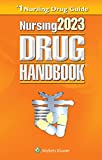
Pharmacology and the Nursing Process
The 10th edition of Pharmacology and the Nursing Process offers practical, user-friendly pharmacology information. The photo atlas contains over 100 unique illustrations and photographs depicting drug administration techniques. Updated drug content reflects the most recent FDA drug approvals, withdrawals, and therapeutic uses.
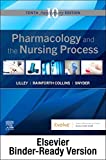
Mosby’s Pharmacology Memory NoteCards: Visual, Mnemonic, and Memory Aids for Nurses
The 6th edition of Mosby’s Pharmacology Memory NoteCards: Visual, Mnemonic, & Memory Aids for Nurses incorporates illustrations and humor to make studying easier and more enjoyable. This unique pharmacology review can be utilized as a spiral-bound notebook or as individual flashcards, making it ideal for mobile study.
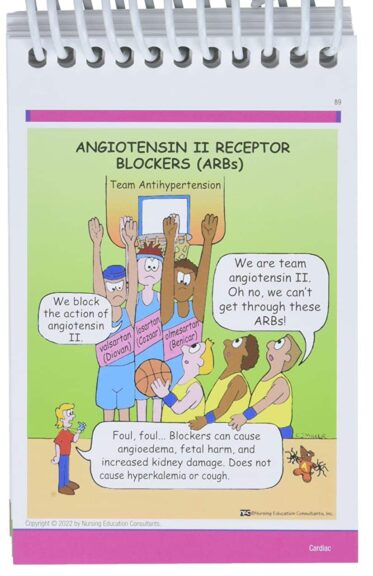
See Also
Here are other nursing pharmacology study guides:
- Nursing Pharmacology – Study Guide for Nurses
Our collection of topics related to nursing pharmacology - Pharmacology Nursing Mnemonics & Tips
These nursing mnemonics aim to simplify the concepts of pharmacology through the use of a simple, concise guide. - Generic Drug Name Stems Cheat Sheet
Learn about these generic drug name stems to help you make sense of drugs easier! - Common Drugs and Their Antidotes
A guide to drug antidotes that nurses should be familiar about. - IV Fluids and Solutions Guide & Cheat Sheet
Get to know the different types of intravenous solutions or IV fluids in this guide and cheat sheet. - Drug Dosage Calculations NCLEX Practice Questions (100+ Items)
Care to take the challenge? This quiz aims to help students and registered nurses alike grasp and master the concepts of medication calculation.
Drug Guides NEW!
Individual drug guides and nursing considerations for the most common medications used in nursing pharmacology:
- Acetaminophen (Tylenol)
- Aspirin
- Atorvastatin (Lipitor)
- Enoxaparin (Lovenox)
- Furosemide (Lasix)
- Gabapentin
- Hydromorphone (Dilaudid)
- Lisinopril
- Metoprolol
- Morphine
Gastrointestinal System Drugs
Respiratory System Drugs
- Antihistamines
- Bronchodilators and Antiasthmatics
- Decongestants
- Expectorants and Mucolytics
- Inhaled Steroids
- Lung Surfactants
Endocrine System Drugs
- Adrenocortical Agents
- Antidiabetic Agents
- Glucose-Elevating Agents
- Hypothalamic Agents
- Insulin
- Parathyroid Agents: Bisphosphonates, Calcitonins
- Pituitary Drugs
- Sulfonylureas
- Thyroid Agents
Autonomic Nervous System Drugs
- Adrenergic Agonists (Sympathomimetics)
- Adrenergic Antagonists (Sympatholytics)
- Anticholinergics (Parasympatholytics)
- Cholinergic Agonists (Parasympathomimetics)
Immune System Drugs
Chemotherapeutic Agents
- Anthelmintics
- Anti-Infective Drugs
- Antibiotics
- Antifungals
- Antineoplastic Agents
- Antiprotozoal Drugs
- Antiviral Drugs
Reproductive System Drugs
Nervous System Drugs
- Antidepressants
- Antiparkinsonism Drugs
- Antiseizure Drugs
- Anxiolytics and Hypnotic Drugs
- General and Local Anesthetics
- Muscle Relaxants
- Narcotics, Narcotic Agonists, and Antimigraine Agents
- Neuromuscular Junction Blocking Agents
- Psychotherapeutic Drugs
Cardiovascular System Drugs
References and Sources
References and sources for this pharmacology guide for Antiviral Drugs:
- Karch, A. M., & Karch. (2011). Focus on nursing pharmacology. Wolters Kluwer Health/Lippincott Williams & Wilkins. [Link]
- Katzung, B. G. (2017). Basic and clinical pharmacology. McGraw-Hill Education.
- Lehne, R. A., Moore, L. A., Crosby, L. J., & Hamilton, D. B. (2004). Pharmacology for nursing care.
- Smeltzer, S. C., & Bare, B. G. (1992). Brunner & Suddarth’s textbook of medical-surgical nursing. Philadelphia: JB Lippincott.
